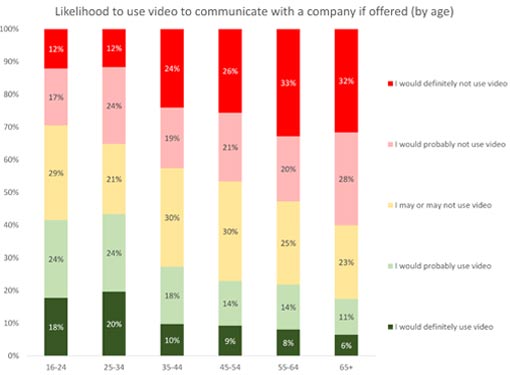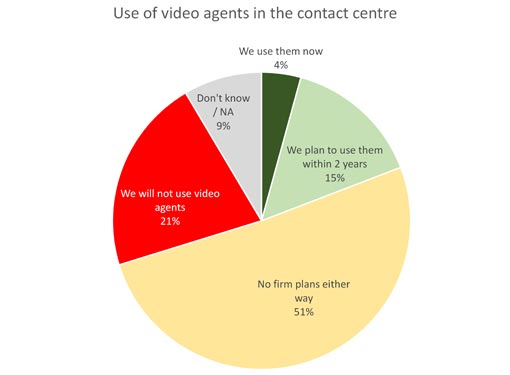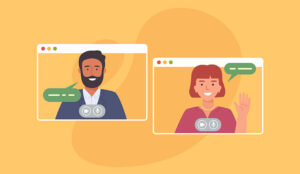Steve Morrell at ContactBabel discusses how video is likely to become more commonplace in business interactions and the benefits it can offer.
While video may not needed for many of the everyday interactions between businesses and customers, there are times when its capabilities can add real value to the customer experience and the outcome of the interaction.
The widespread use of video throughout the pandemic – for talking to family and friends as well as work colleagues – means that this channel has become very familiar to many of us.
Video agents are a step towards more personalised, high-quality customer contact.
The imminent widespread rollout of 5G will make the smartphone an even more powerful device, and we can expect that the high bandwidth available will encourage businesses to offer both real-time and recorded video as part of their customer communication mix.
It’s important to understand that offering live video to customers is not appropriate for every business.
As shown in the chart below, a survey of 1,000 UK customers carried out for ContactBabel’s “Inner Circle Guide to Video and Next-Gen Customer Contact” finds that different demographics have varying views on video, with younger customers far more likely to be amenable to using this channel.

The survey also looked at how customers’ attitudes to using video have changed over lockdown.
Of those who expressed concern over using video, 54% felt uncomfortable about seeing a stranger on a video call, a higher proportion than those who did not want to be seen by the business (30%).
43% stated that they could already carry out their business effectively with existing channels, and 19% said that they did not have the technology to make video calls.
Looking at the differences by age group, younger people are somewhat more likely than older ones to say that they have always been comfortable using video, probably as a result of the messaging apps that many of them use regularly.
These younger age groups are also far more likely to have become more comfortable with using video over lockdown.
For interactions where trust and empathy are especially important, and where the issue may be complex, video can provide a level of service that telephony cannot match.
Live video use cases include:
Sales
For a retailer selling high-value items on a website, the option to have a video call looks to be a very good idea.
With cart abandonment rates reportedly averaging around 70% , having a relatively high-cost channel such as click-to-video available at the point of sale could in theory prove highly profitable.
Some retailers choose to offer video to potential purchasers rather than for after-sales service (for which they may offer web chat), which allows the demonstration of products as well as the chance to cross-sell, upsell and offer insurance.
This also allows businesses to consider a reduction in the number of physical stores that they have, as the website / contact centre can then act as a virtual store.
Healthcare
The coronavirus pandemic has hugely accelerated a gradual move towards offering remote medical services. In some part, these have been restricted to telephone-based consultations which by their nature do not allow for visual examination and rely upon the patient’s own description of symptoms.
Video consultations provide a significant upgrade on this, providing more accurate information for triage and offering a way forward for primary healthcare providers as well as advice lines such as NHS 111 in the UK.
The few studies of the effectiveness of video health consultations in outpatient environment suggest high patient and clinician satisfaction, and similar levels of disease progression in chronic cases.
While video consultations are a significant step up on telephony-only appointments, they currently appear unlikely to replace face-to-face consultations for acute conditions, for those which require physical examinations, or for certain types of patient (for example, those unable to use technology effectively, or those which do not possess it).
Financial Services
Various businesses – usually banks – are already using video kiosks to offer virtual branch banking services in areas where physical branches have closed.
Skilled mortgage advisors, legal advisors and financial consultants who may otherwise have made a home visit can be put in front of potential customers immediately, saving their time.
Many customers may welcome this, rather than feeling that they have to welcome a stranger into their home. Offering remote video consultations can also make appointments out-of-hours more palatable to all concerned.
Insurance
Many insurance companies are already asking customers who are making claims to upload photographic evidence of damage, and video can take this one step further by providing a clearer and more complete picture of the reason for the claim, increasing accuracy and reducing fraudulent claims.
This reduces the need for the insurer to send out an assessor, which is beneficial for the customer as well as the business. Agents can also be trained to identify tell-tale visual signs of dishonesty.
Technical Support
One of the most high-profile examples of video technical support was Amazon’s Mayday service, offered on the Fire tablets from 2013. Despite its popularity with customers, it was quietly dropped in 2018.
It may have been that it was a victim of its own success, becoming the most popular way to access technical support which would have impacted costs considerably (particularly as Amazon’s Alexa virtual assistant has become ubiquitous).
Businesses looking to consider video agents may wish to consider what the likely demand will be, and possibly offer it only in certain circumstances and to specific customers. If the choice is between a phone call and a video call, then the interaction length (and therefore cost) is likely to be similar.
However, if self-service could carry out a high proportion of initial requests, then video may best be left as a 2nd- or 3rd-line support option.
Product Support Demonstrations
If the agent has the product to hand, it is far easier to show the customer how to use it, rather than try to explain it (which may often involve jargon which is frustrating for the customer).
Complaints
While there are not many businesses currently using video agents to handle complaints, it can be theorised that demonstrating empathy is easier in a video call than in a phone call, and that the customer is likely to get less frustrated and angry if they can see who they’re talking to, rather than just another “faceless employee”.
Video is seen by customers as a premium channel, and this may also show that the company is taking their issue seriously. This may also apply to renewals or where the customer has said that they wish to cancel a subscription.
Although only 4% of the 200+ UK contact centres surveyed for the report stated that they were using video now, 15% have definite plans to do so by 2023, and only around 1 in 5 have made a definite decision not to do so.


Steve Morrell
The major drivers for implementing video were reported to be that agents could offer more personalisation and demonstrate empathy, with the ability to demonstrate products and services also being seen as a major advantage.
It was also stated that video was more often currently used in sales or account management roles rather than customer service.
“The Inner Circle Guide to Video & Next-Generation Customer Contact” is available for free download from www.contactbabel.com.
Author: Robyn Coppell
Published On: 22nd Jun 2021 - Last modified: 11th Apr 2024
Read more about - Guest Blogs, ContactBabel, Steve Morrell





































